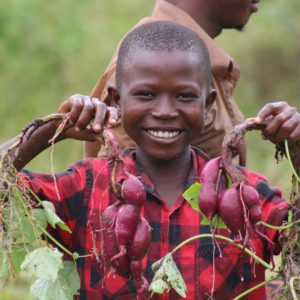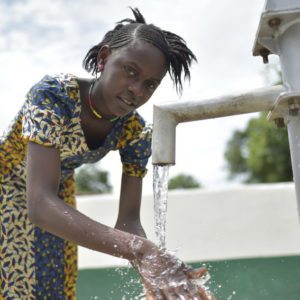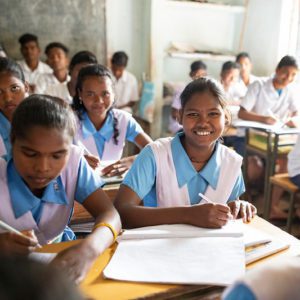ChildFund Stories
Find out about the amazing work that ChildFund does
The struggle against hunger in Sierra Leone
In most rural areas of Sierra Leone – as in many of the communities where ChildFund works – families’ quality of life depends heavily on the quality of the harvest from their crops. More than 60 percent of Sierra Leone’s population lives in rural communities, and the majority of them are subsistence farmers.
Here, rice is the staple food, but it can only be harvested in the dry season from December to April. In the rainy season from May to November, a bag of imported rice costs around $35 USD – difficult even for more affluent families in the capital city to afford. In rural communities, families like Momoh’s must get creative to survive. Hundreds of thousands of Sierra Leoneans are severely food insecure, and child hunger is common.
Crops like cassava, sweet potato and yam come in handy during these months. The orange-fleshed sweet potatoes Momoh’s family has harvested are in especially high demand for their incredible flavor and high levels of nutrients. Rich in vitamin A, they are a powerful preventive for malnutrition.
12-year-old Momoh from rural Bombali District, Sierra Leone
12-year-old Rugiata washes her hands at a new well built by ChildFund
Celebrate 10 billion liters of clean water
One of the major problems facing families in poverty is a lack of clean water. Nearly 1 billion people face this challenge daily. Mothers and children walk miles in some communities to get water for drinking and cooking, but it often makes them ill with diarrhea, cholera, dysentery and typhoid, which claim more children’s lives than AIDS and malaria combined.
To address this massive challenge, the P&G Children’s Safe Drinking Water program was started in 2004, working with a global network of nongovernmental organizations (including ChildFund) to provide families and communities with water purification packets that make dirty water clean both quickly and easily.
In May, Procter & Gamble celebrates a milestone: the delivery of its 10 billionth liter of clean drinking water. A family in Mexico is receiving the 10 billionth liter on May 3, an event that will be followed by a series of celebrations involving CSDW and its partners worldwide.
Water purification packets, which are delivered to households, schools, early childhood development centers and health care clinics, make a major difference for communities. Even if families are gathering water that is obviously dirty, using a packet makes the water clean and healthy in a matter of minutes.
Girls’ education: Challenge & Solutions
Primary among the barriers to girls’ education are poverty, gender-based violence and social and cultural attitudes about the roles of women and girls. Like Feremusu, many girls in developing communities fall victim to their families’ belief that it is a waste of money to send girls to secondary or even primary school. Others cave to cultural or financial pressure to get married young. Still others must drop out to help provide for their families. That was the case for Gita.
The summer of 2019 was one of the hottest on record. Even so, most of the kids in Gita’s town in Keonjhar District, India, were going back to school after their usual March-May break, buzzing with the excitement of entering a new grade, meeting new teachers and making new friends.
Gita herself was supposed to be entering the eighth grade, but she couldn’t. Both of her parents had just fallen seriously ill with malaria. The family could barely afford food, so medical treatment was out of the question. As the only girl in her family, not to mention the oldest, Gita had no choice but to drop out of school and work in the sweltering rice fields – long days of backbreaking labor in more than 100-degree heat. She was 14.
“I wasn’t thinking about the heat,” Gita says. “I was more concerned with my parents and their health.” Her family had to survive, and her little brothers’ education was more important.
When ChildFund’s local partner organization learned about Gita’s situation, they worked to get her parents to a local hospital for treatment and get Gita back into school. Today, Gita’s parents have made a full recovery, and she’s pursuing her dream of becoming a teacher.
Gita at school
ChildFund staff shares resources about positive parenting during COVID-19 crisis
ChildFund’s COVID-19 Response
The devastating impact of the COVID-19 pandemic on children around the world cannot be overstated. At the start of the crisis, many governments moved swiftly to enact rules aimed at slowing the spread of the virus – but in doing so, they also halted critical prevention and response services designed to protect children from threats such as economic instability, lack of health care and violence, sparking a parallel crisis in many homes and communities.
The work we do at ChildFund is built upon the intimacy of social connection. Through a hyper-localized approach, working through hundreds of local partners, we are able to reach 13.6 million children and family members in their homes, schools, and communities in 24 countries worldwide. The loss of this intimacy due to the pandemic is being felt acutely by staff and families alike, creating an unprecedented challenge to ensuring that the children we care for can thrive even in these difficult times.
At the start of the pandemic, we worked to swiftly address children’s immediate needs, including food insecurity, family economic instability, social and emotional stress, and education and social services disruption. These needs were, and remain, urgent. However, through our hyper-local approach, ChildFund has been able to quickly pivot programming under these extraordinary circumstances, especially where community-based child protection mechanisms have already been integrated. And as we all move into a “new normal” of pandemic life, we continue to reach children and families who need assistance at ever-growing numbers.
Ending Violence Against Girls in Central America
According to most measures of the world’s well-being, countries are better off than ever. But the chasm between the haves and the have-nots has grown. In Latin America’s Northern Triangle countries, which lack social safety nets like those in the United States, income inequality perpetuates the rampant violence for which the region is known. Children in marginalized communities are the most vulnerable — especially girls.
The story of girls in Central America too often goes like this: Organized crime moves into poor communities, targeting disenfranchised boys for gang recruitment. The boys capture girls to be their partners. The girls become pregnant and the boys abandon them, leaving them with no skills, limited options and, in their arms, a member of a new generation of prey for gangs.
Parents try to protect their girls by strictly controlling them, forbidding them from going outside, into town or, often, even to school. Enforcing these restrictions through harsh corporal punishment, parents do not understand how their fears harm girls’ development. It’s no surprise that children in the region cite home as the most violent place in their world. But violence permeates the entire ecosystem in which children grow up, including school and the community. For girls, violence is not only physical but also psychological, sexual and economic. It is also a source of shame and, thus, rarely reported.
Organizations like ChildFund International have much to contribute toward helping children and families address the violence surrounding them. We know that effective responses to violence against children must be informed by children’s perspectives and must involve them in finding solutions. Worldwide, ChildFund does this through working with community members to map out local places and patterns of violence, consulting children themselves about their perceptions of risks and resources, including people, that can help reduce dangers.
Yeimi, 10, lives in a community rocked by violence in Santa Barbara Department, Honduras.
NO PURCHASE OR DONATION NECESSARY. Void where prohibited. Open to legal residents of the U.S. and D.C. (excluding Oregon) 18 years or older. Weekly sweepstakes Prize Draws based on eligible entries received on or after Tuesday 12:01 am ET and before the following Monday at 11:59pm ET. Prize Draws will occur the following Friday. Entry period begins on May 24, 2021 and weekly Prize Draws shall continue until further notice. First Prize Draw shall take place on June 11, 2021. Prize/Odds: Total ARV of all Prizes available in each weekly Prize Draw: $700. Odds of winning depend on the total number of eligible entries received. Subject to Official Rules located at https://childfunddrawforhope.org/rules/. Operator: Zenterprize Inc., 600 B Street, Suite 300, San Diego, CA 92101.





